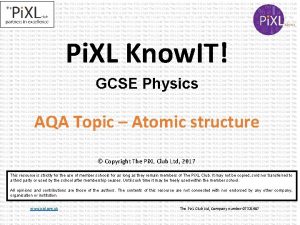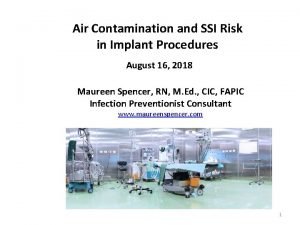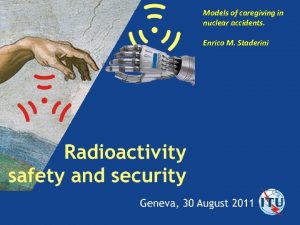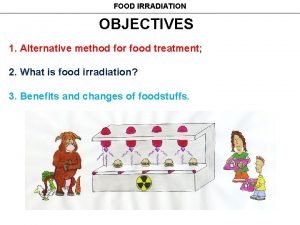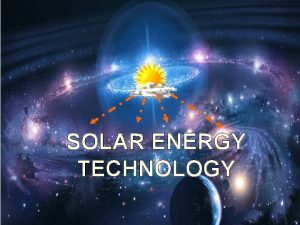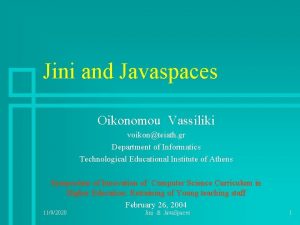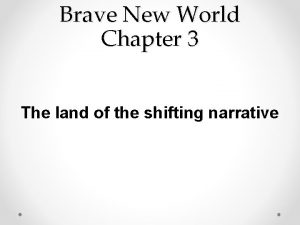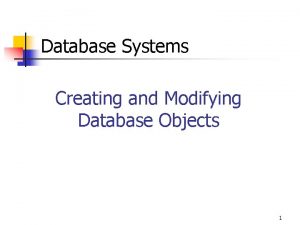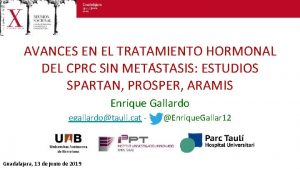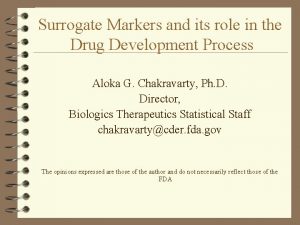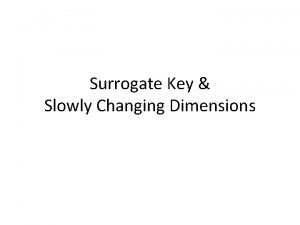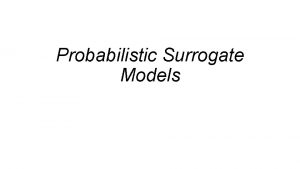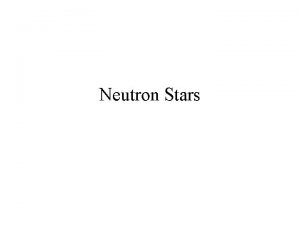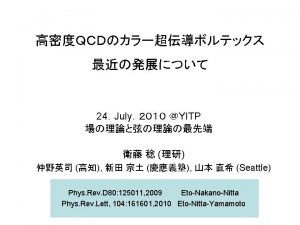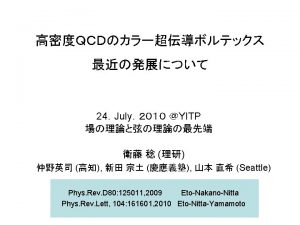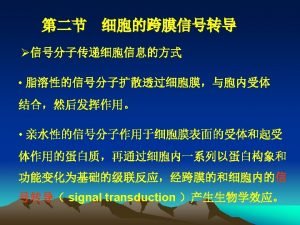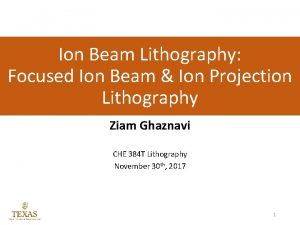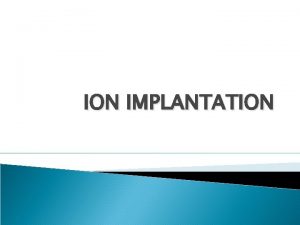Ion irradiation used as surrogate for neutron irradiation















- Slides: 15

Ion irradiation used as surrogate for neutron irradiation to understand nuclear graphite evolution during reactor operation: consequences for the long lived radionuclide’s behavior N. Toulhoat 1, 2 , N. Moncoffre 1, Y. Pipon 1, N. Bérerd 1 1 Université 2 de Lyon, CNRS/IN 2 P 3, IPNL, France CEA Centre de Saclay, France CAST Symposium January 16 th – 18 th 2018 1

aim Partner n° 28 Our CNRS/IN 2 P 3 (IPNL) Task 5. 2: Develop approaches to characterise the 14 C inventory in irradiated graphites Study the effects of neutron irradiation on the behaviour of 14 C and provide information on 14 C distribution, chemical state and release after reactor shutdown Same job on 36 Cl (T 1/2 ~ 300 000 years, released due to the mobility of Cl- in clay host rocks) Virgin nuclear graphite or model graphite (HOPG) 13 C or 36 Cl implanted : simulate 14 C displaced from its original structural site through recoil Ion irradiation : simulate neutron irradiation CAST Symposium January 16 th – 18 th 2018 2

What we already know on 14 C and 36 Cl in nuclear graphite : two different origins inducing contrasted locations 14 C issued from 14 N(n, p)14 C (mainly close to pores 14 N is adsorbed during maintenance cycles) released by radiolytic corrosion (in CO 2 cooled reactors) 36 Cl 14 C issued from 13 C(n, g)14 C (mainly in the bulk) stable up to T ~ 1600°C 13 C 14 N : mainly produced through the activation of 35 Cl (nuclear graphite impurity) 36 Cl 35 Cl(n, g)36 Cl release related to the structure of graphite located at crystallite edges released from T = 200°C 36 Cl located inside crystallites released at T > 1200°C C. E. Vaudey et al. Journal of Nuclear Materials 395 (2009) 62 -68 C. E. Vaudey et al. Journal of Nuclear Materials 418 (2011) 16– 21 A. Blondel et al. Carbon 73 (2014) 413 -420 N. Toulhoat et al. Journal of Nuclear Materials 464 (2015) 405– 410 3 CAST Symposium January 16 th – 18 th 2018 G. Silbermann et al. Nuclear Instruments and Methods in Physics Research Section B 332 (2014) 106 -110 N. Moncoffre et al. Journal of Nuclear Materials 472 (2016) 252 -258

Question : Behavior of 14 C and 36 Cl during reactor operation? Impact of neutron irradiation + temperature on the 36 Cl 14 C and behavior? ü How does irradiation modify the graphite structure ü How does the structure modification influence the radionuclides release? CAST Symposium January 16 th – 18 th 2018 4

37 Cl or 13 C implantation to simulate Filler (Coke grain ) 36 Cl or 14 C ~ 80% Binder (made of coal tar pitch) Highly Ordered Pyrolytic Graphite HOPG to simulate coke grains Well ordered Pore Nuclear graphite 37 Cl (at. ppm) Ion implantation Implantation 3 x 1013 37 Cl. cm-2 ~ 25 ppm 37 Cl Less ordered 37 Cl or 13 C 13 C HOPG model graphite (at. %) 6 x 1016 13 C. cm-2 ~ 4 at. % implantation to simulate 36 Cl or 14 C (measured by SIMS) Depth (nm) CAST Symposium January 16 th – 18 th 2018 5

Two different structural states Implantation alows simulating two different structural states : Ø less disordered Ø highly disordered G mode : planar vibrations of C atoms D mode : hetero-atoms, vacancies, grain boundaries and other defects ID 1/IG and FWHMG parameters : monitor the graphite structure disorder CAST Symposium January 16 th – 18 th 2018 6

Ion irradiation to simulate neutrons Neutrons generate atom displacements producing mainly Ballistic damage (1 - 3 dpa) Recoil carbon atoms transfer some energy through excitations and ionisations Method Stopping power (Stot) = Nuclear stopping power (Sn) + Electronic stopping power (Se) Ions used to simulate neutron irradiation effects Ballistic regime is favored Electronic regime is favored CAST Symposium January 16 th – 18 th 2018 9

Structure evolution Less disordered structure through implantation 3 D reordering Ballistic Electronic In plane reordering Ø Ballistic irradiation (dpa >> 1) : strong disordering compensated by temperature annealing effects Ø Electronic regime or ballistic at low dpa level : almost no impact on disordering CAST Symposium January 16 th – 18 th 2018 8

Structure evolution Highly disordered structure through implantation HRTEM and squeletonized images Ø Temperature alone or electronic regime : no impact Increase of the size of the coherent domains Ø Ballistic irradiation + temperature : three dimensional reordering of the structure CAST Symposium January 16 th – 18 th 2018 9

Reordering process Highly disordered structure through implantation D FWHM = FWHM irradiated FWHM unirradiated Ea ~ 0. 09 e. V Higher Ea values reported in the literature to achieve three dimensional temperature reordering Very low reordering activation energy Athermal radiation enhanced annealing process (break-up of clusters and vacancy-interstitial annihilation) CAST Symposium January 16 th – 18 th 2018 10

37 Cl release under irradiation C + Irr. 500°C Ar+ Irr. 200°C Ar + Irr. 1000°C Ar + Irr. 500°C Argon irradiation (dpa >> 1) break the graphene planes Argon ions 37 Cl CAST Symposium January at broken crystallite edges is released 16 th – 18 th 2018 11

13 C release under irradiation Almost no 13 C release whatever the irradiation conditions 13 C might be stabilized into new formed carbon clusters? CAST Symposium January 16 th – 18 th 2018 12

Inferred behavior for Irradiation (ballistic damage) + Temperature 14 C and 36 Cl in irradiated graphite Favor 14 C incorporation into new carbon structures Favor 36 Cl release (more than 30% released in hot and highly irradiated areas) Nature and initial structural state (binder, coke), irradiation history and position of graphite in the reactor will lead to significant structural heteroneneities ---- Depleted 36 Cl zones High temperature annealing (T > 1300°C) prior to disposal should in any case be beneficial To stabilize 14 C To release 36 Cl bound to edge planes (which should be more accessible to leaching) 13

This presentation is mainly based on results issued from the Ph. D of N. Galy (2013 - 2016) Our results are also the fruit of cooperation with M. R Ammar and P. Simon from CNRS/CEMHTI Orléans, France J. N. Rouzaud and D. Deldicque from Ecole Normale Supérieure , Groupe de Géologie, Paris, France P. Sainsot from Université de Lyon, INSA-Lyon, France CAST Symposium January 16 th – 18 th 2018

The authors are very grateful to Financial support Technical support The European (Euratom) Programme FP 7/2007 -2013 under the grant agreement n° 604779 (CAST 14) IPNL accelerator staff (VDG 4 MV and IMIO 400) ICUBE laboratory, Strasbourg University TANDEM accelerator staff, Orsay CEMHTI accelerator staff, Orléans Thank you for your attention ! CAST Symposium January 16 th – 18 th 2018
 Thorium
Thorium Ultra violet germicidal irradiation
Ultra violet germicidal irradiation Irradiation vs contamination
Irradiation vs contamination Gamma irradiation sterilization process
Gamma irradiation sterilization process Solar energy syllabus
Solar energy syllabus Vapor pressure and intermolecular forces
Vapor pressure and intermolecular forces C6h12 fuerza intermolecular
C6h12 fuerza intermolecular Fuerzas dipolo dipolo ejemplos
Fuerzas dipolo dipolo ejemplos Fuerzas de london
Fuerzas de london Surrogate buyers in consumer behaviour
Surrogate buyers in consumer behaviour Jini dep
Jini dep Vibro vacuum brave new world
Vibro vacuum brave new world Apush unit 2 review
Apush unit 2 review Surrogate key oracle
Surrogate key oracle M0crpc
M0crpc What is a surrogate marker
What is a surrogate marker
